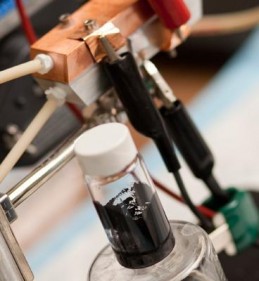New battery design could be breakthrough for electric vehicles and grid storage
June 7, 2011

A sample of "Cambridge crude," a black, gooey substance that can power a highly efficient new type of battery. A prototype of the semi-solid flow battery is seen behind the flask (credit: Dominick Reuter)
Researchers at MIT have developed a radically new approach to the design of batteries that could provide a lightweight, inexpensive alternative to existing batteries for electric vehicles and the power grid.
The new battery relies on an innovative architecture called a semi-solid flow cell, in which solid particles are suspended in a carrier liquid and pumped through the system. In this design, the battery’s active components — the positive and negative electrodes (cathodes and anodes) — are composed of particles suspended in a liquid electrolyte. These two different suspensions are pumped through systems separated by a filter, such as a thin porous membrane.
One important characteristic of the new design is that it separates the two functions of the battery — storing energy until it is needed, and discharging that energy when it needs to be used — into separate physical structures.
Halving the size with ten times more energy density
This new design should make it possible to reduce the size and the cost of a complete battery system, including all of its structural support and connectors, to about half the current levels. The researchers said that this dramatic reduction could be the key to making electric vehicles fully competitive with conventional gas- or diesel-powered vehicles. This means a ten-fold improvement in energy density over present liquid flow-batteries, and lower-cost manufacturing than conventional lithium-ion batteries.
Another potential advantage is that in vehicle applications, such a system would permit the possibility of simply “refueling” the battery by pumping out the liquid slurry and pumping in a fresh, fully charged replacement, or by swapping out the tanks like tires at a pit stop, while still preserving the option of simply recharging the existing material when time permits.
Scalable at low cost, making intermittent wind and solar energy practical
The new battery system could also be scaled up to very large sizes at low cost. This would make it particularly well-suited for large-scale electricity storage for utilities, potentially making intermittent, unpredictable sources such as wind and solar energy practical for powering the electric grid.
The new technology is being licensed to a company called 24M Technologies.
Ref.: Yet-Ming Chiang, et al., Semi-Solid Lithium Rechargeable Flow Battery, Advanced Energy Materials, 20 May 2011 [DOI: 10.1002/aenm.201100152]